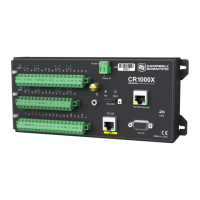measurement accuracy. When MeasOff = True, a measurement of the single-ended offset
voltage is made at the beginning of the VoltSE() or TCSe() instruction. When MeasOff =
False, measurements will be corrected for the offset voltage determined during self-calibration.
For installations experiencing fluctuating offset voltages, choosing MeasOff = True for the
VoltSE() or TCSe() instruction results in better offset voltage performance.
If RevDiff, RevEx, or MeasOff is disabled ( = False), offset voltage compensation is
automatically performed, albeit less effectively, by using measurements from the background
calibration. Disabling RevDiff, RevEx, or MeasOff speeds up measurement time; however,
the increase in speed comes at the cost of accuracy because of the following:
l RevDiff, RevEx, and MeasOff are more effective.
l Background calibrations are performed only periodically, so more time skew occurs
between the background calibration offsets and the measurements to which they are
applied.
NOTE:
When measurement duration must be minimal to maximize measurement frequency,
consider disabling RevDiff, RevEx, and MeasOff when datalogger temperatures and
return currents are slow to change.
6.2 Current-loop measurements
RG terminals can be configured to make analogue current measurements using the
instruction. When configured to measure current, terminals each have an internal resistance
of 101 Ω in the current measurement loop. The return path of the sensor must be connected
directly to the G terminal closest to the terminal used. The following image shows a simplified
schematic of a current measurement.
6. Measurements 61

